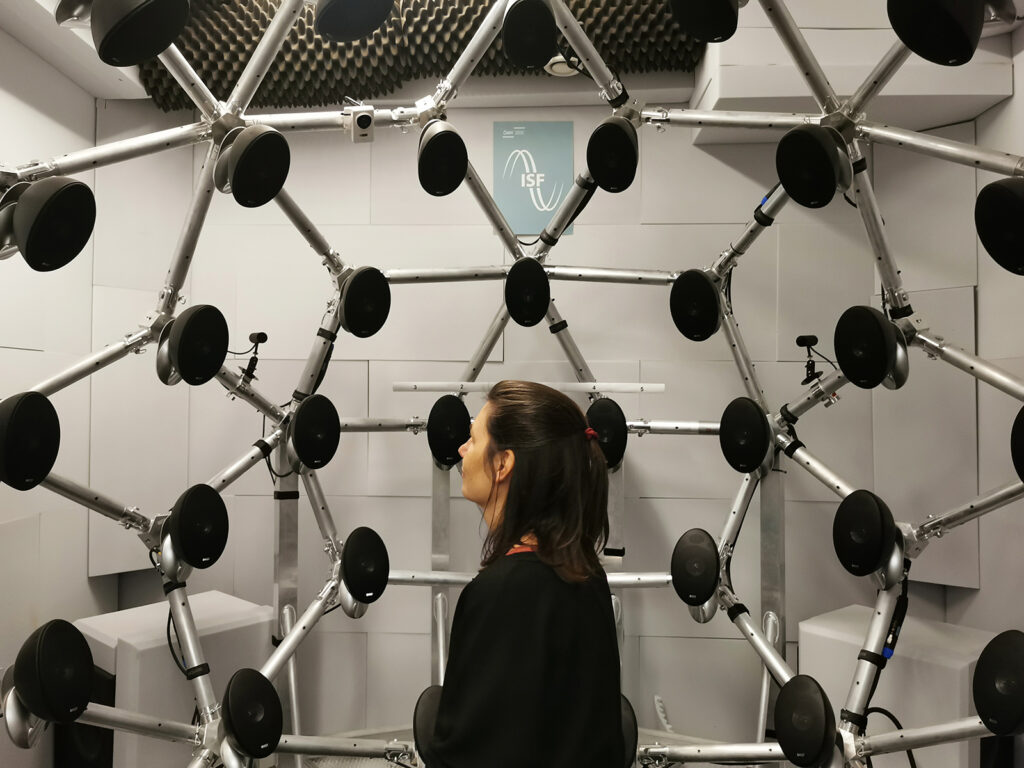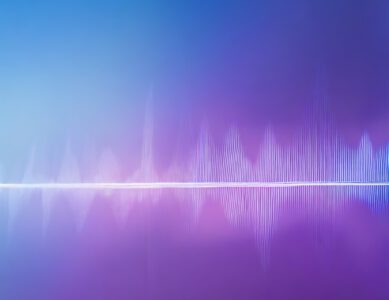AUDIO GHOSTS: Illusive perceptions – Perceptual illusions
Towards a practice-based exchange between psychoacoustics and installative sound art
Introduction
Imagine you encounter an immersive listening experience which substantially changes your way of thinking about sound and perception, and eventually may even influence your understanding of one’s role and place in society in general. This, in a nutshell, is our vision and motivation to engage with the arts-based research project AUDIO GHOSTS.
Combining artistic, psychoacoustic, sociological and technological expertise, we seek to explore the crossings of science and art, embodied and sensorial knowledge. Based on specific auditory illusions, we create case studies of sound installations that reflect the artistic potential of psychoacoustic phenomena and their perceptual and societal implications. In the second phase of the project, eight guest artists are invited to conduct their individual artistic research based on our models, generating further (tacit) knowledge about space-related psychoacoustic phenomena in sound installations. During the final phase the project will be opened up to other artistic positions, including perspectives from (freely improvised) acoustic music, music theatre, neuroscience, and audiovisual art. All creative processes will be accompanied by critical evaluation and reflection in various formats.
Sound art is situated at the fringes of contemporary music and visual arts, predominantly, involving genres such as experimental and electroacoustic music, installation art and media art, as well as scientific disciplines such as musicology, art history and open research domains such as sound studies. Given its transdisciplinary nature, theoretic considerations relate to a mix of disciplines including aesthetics, acoustics, architecture, music psychology, neuroscience, philosophy of art, and sociology. Unlike traditional music performances which usually employ defined durations and prescribed listening perspectives, sound installations require to be explored individually, leaving many aesthetic and perceptual choices to the recipients, regarding the length of a visit, preferred listening positions and perspectives, bodily motion through the installation space and so forth. Thus, visitors are turned into ‘co-authors’ who complete the ‘proposed’ art work through personal interactions in a highly individualized manner.
Aims, hypotheses and arts-based research questions
With the project AUDIO GHOSTS we aim to create intense auditory-induced perceptual spaces that transcend everyday routines. Our objective is to produce tacit (embodied, sensorial) knowledge through iterative and reflexive processes, addressing issues of perceptual manipulation and (self )reflexivity. Based on the artistic exploration of auditory illusions and related psychoacoustic phenomena, we strive to generate insights into the intersubjectivity of aesthetic and social interaction (Seale, 2018).
We investigate listening processes as aesthetic strategies for the creation and perception of sound installation art. This is the research gap we aim to fill with this project. Based on selected psychoacoustic models which are devised in collaboration with the Acoustics Research Institute (ARI) of the Austrian Academy of Sciences, we create aural knowledge for further compositional (and perceptual) processes. Installative sound presentations need to be explored and reflected in space/on site. Thus, our artistic research oscillates between producing, evaluating, and adapting, between imagining and experiencing. The acquired knowledge – knowing in listening (Zembylas et al, 2018) – will serve as a starting point for invited guest artists to engage in individual arts-based research.
Hypotheses & research questions
AUDIO GHOSTS elaborates on key issues of auditory perception and psychoacoustic phenomena, regarding the intersubjectivity of listening processes in sound installation art. The following hypotheses and research questions serve as a starting point and conceptual framework:
a) In presentations of sound art, psychoacoustic phenomena can be associated with intense sensorial experiences.
⇒ Which perceptual competences need to be enhanced in order to ‘perform’ sound installations as an activated listener?
b) The individuality of space-oriented listening in sound installations is of constitutive significance for appropriate compositional strategies. Specific auditory illusions may serve as sources of inspiration or as structural foundations for compositional case studies.
⇒ How can compositional case studies be modelled on the basis of auditory illusions, challenged by non-narrative time structures?
c) The transformation of psychoacoustic principles into compositional strategies may lead to the production of new tacit knowledge about sound installation art as well as psychoacoustics.
⇒ How can the aesthetic potential of sound installations be investigated using methods of arts-based research?
d) The sensual exploration of sound installations may promote one’s understanding of the socio-political dimension of ‘activated listenership’ (Voegelin, 2010). Deciphering spatial sound works through one’s own perceptual choices can evoke ‘moments of awe’ (Fischer-Lichte, 2004), a self-referential involvement that can ultimately lead to an increased appreciation of ‘the human condition’ and encourage sensitive and respectful relations with other members of society.
⇒ To what extent can tacit (sensorial, embodied) knowledge gained through the process of perceiving sound art be beneficial for future interactions with others / for society?
e) The ubiquitous presence of smartphones and streaming technologies may lead to the isolation of the individual within society and thus a repudiation of social interaction and communal connectedness.
⇒ To which degree can sound installations enhance physical, sensual, and emotional experiencing?
Methods
Our main methodical approach is to investigate ‘knowing in listening’ as a process of tacit knowledge gathering and a socio-political practice of sound. The goal of this project is to create an extensive body of research material — sound installations — by investigating auditory illusions and associated psychoacoustic principles, and their role in creating and perceiving site-specific works of sound art. Scientific methods and paths of knowledge from psychoacoustics are taken up and ‘transferred’ into perceptual case studies, initiating both experimental and critically reflective processes of knowledge production. This includes documentation, theoretical contemplation and reflection on the methods chosen, and on the relation between researchers and the research process.
Sound installations have to be ‘performed’ by an acting audience (Fischer-Lichte, 2004). In this project we investigate listening as an intersubjective dialogue. Following Luhmann’s (1995) system-theoretical communication model, one could speak of ‘second-order producers’, for it is only in the processual concretization through hearing, seeing, and moving of the recipients that the proposed work structure is turned into individually explored works of art.
AUDIO GHOSTS can be divided into three (overlapping) stages: Stage 1 mainly involves the core team of the project, consisting of artists-researchers Bernhard Gál and Veronika Mayer, supported by an expert from the Acoustics Research Institute. We create a sound laboratory for arts-based research on auditory phenomena, conceiving case studies and compositional miniatures. Stage 2 expands its scope to include collaborations with invited guest artists, research visits, and initial sound presentations (installation series Audio Ghosts 1-8). Finally, Stage 3 includes the dissemination of produced knowledge through public presentations (workshops, symposium, festival) as well as the creation of an audio archive and participation in relevant conferences. At all stages, the project is accompanied by a critical discourse with the members of the advisory board.
AUDIO GHOSTS: Sound environment for arts-based research on auditory phenomena
Based on the expertise of our National Research Partner, the Acoustics Research Institute (ARI) of the Austrian Academy of Sciences (OeAW), we will design a modular sound research environment to investigate creative processes between producing, evaluating and rebuilding, between envisioning and experiencing. The Loudspeaker Array Studio (LAS) will be available for the project team, providing ample space for experimentation and reflection.

[Veronika Mayer experiencing the Loudspeaker Array Studio of the ARI]
As a point of departure, we will realise a series of compositional miniatures using multi-channel loudspeaker arrays that will be set up specifically to suit the respective auditory models. In the second and third phase of the project, invited guest artists will conduct additional artistic research based on our models and the AUDIO GHOSTS sound environment.

